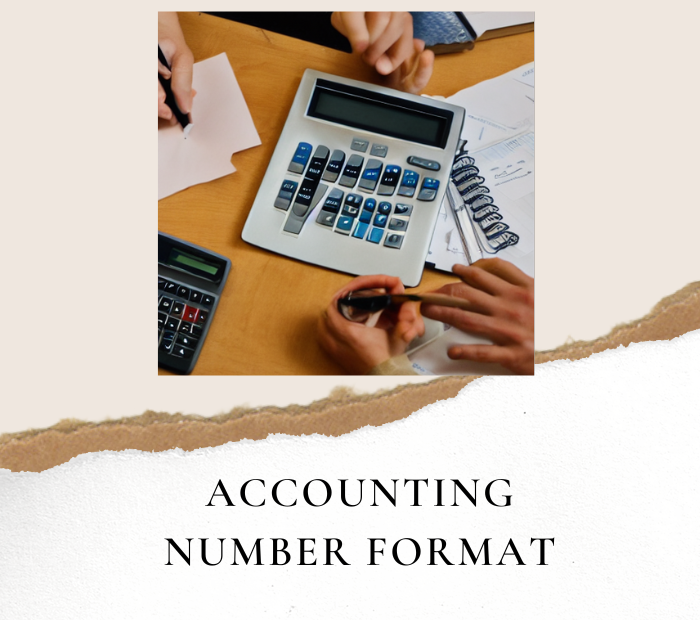The accounting number format is a way of formatting financial numbers in spreadsheets or accounting software to make them easier to read and understand. In this format, negative numbers are shown in parentheses and numbers are right-aligned with the currency symbol aligned to the left. For example, the number “-500” would be displayed as “(500.00)” in the accounting number format, with the negative number shown in parentheses and two decimal places displayed for cents. Similarly, the number “1,500” would be displayed as “$1,500.00” with the dollar sign aligned to the left and two decimal places displayed for cents. The accounting number format is commonly used in financial reports, such as balance sheets, income statements, and cash flow statements, to present financial information in a clear and consistent manner.
Read More: EPES Accounting: A Comprehensive Guide to Streamlining Your Financial Processes
Why it is important to know about accounting number format
It is important to know about the accounting number format for several reasons:
- Clarity: This is designed to make financial data clear and easy to read. This is especially important when dealing with large amounts of data and complex financial information. By using a consistent format for financial numbers, it is easier to understand and analyze financial data.
- Accuracy: This also helps to ensure accuracy in financial calculations. By using a standardized format, it is less likely that errors will be made in data entry or calculations.
- Compliance: Many organizations and financial institutions require the use of the accounting number format in financial reports to ensure consistency and compliance with accounting standards. For example, the Generally Accepted Accounting Principles (GAAP) require the use of specific formatting conventions in financial statements.
- Comparison: This also makes it easier to compare financial data across different periods or between different companies. By using a standardized format, it is easier to compare financial data and identify trends or anomalies.
So, This format is an important tool for anyone involved in financial reporting or analysis. It helps to ensure clarity, accuracy, compliance, and comparability in financial data.
How accounting number format is related to accounting standard and principle
The accounting number format is related to accounting standards and principles in several ways:
- Compliance with accounting standards: This is often required by accounting standards, such as the Generally Accepted Accounting Principles (GAAP) or International Financial Reporting Standards (IFRS), for financial reporting. These standards specify the formatting and presentation of financial data to ensure consistency and comparability across different companies and periods.
- Consistency with accounting principles: This is consistent with accounting principles, such as the principle of comparability and the principle of consistency. By using a standardized format for financial numbers, it is easier to compare financial data across different companies and periods, and to ensure that financial data is presented consistently over time.
- Accuracy and transparency: This is designed to promote accuracy and transparency in financial reporting. By using a consistent format for financial numbers, it is easier to identify errors or discrepancies in financial data, and to ensure that financial information is presented in a clear and understandable manner.
So, This format is an important tool for ensuring compliance with accounting standards, consistency with accounting principles, and accuracy and transparency in financial reporting. By using a standardized format for financial numbers, it is easier to compare financial data, identify trends, and make informed decisions based on financial information.
Implication of accounting number format in traditional accounting:
- Manual calculations: Traditional accounting practices involve manual calculations and record-keeping, often using paper ledgers and journals. In this context, this helps to ensure consistency and accuracy in financial data, making it easier to reconcile accounts and identify errors.
- Compliance with accounting standards: Traditional accounting practices are often based on established accounting standards, such as the Generally Accepted Accounting Principles (GAAP), which specify the formatting and presentation of financial data. This t is an important tool for complying with these standards and ensuring consistency in financial reporting.
- Limited access to data: Traditional accounting practices may have limited access to financial data, making it important to present financial information in a clear and understandable format. This can help to achieve this goal by providing a consistent and easily readable format for financial numbers.
Implication of accounting number format in modern accounting:
- Automated accounting systems: Modern accounting practices often involve automated accounting systems, such as accounting software and cloud-based accounting platforms. In this context, this can be applied automatically, ensuring consistency and accuracy in financial data.
- Data analytics and visualization: Modern accounting practices often involve the use of data analytics and visualization tools, which can help to identify trends, patterns, and anomalies in financial data. this is an important tool for these activities, as it provides a consistent and easily readable format for financial numbers that can be easily analyzed and visualized.
- Real-time access to data: Modern accounting practices often provide real-time access to financial data, making it important to present financial information in a clear and easily understandable format. this can help to achieve this goal by providing a consistent and easily readable format for financial numbers that can be accessed in real-time.
So, the accounting number format is an important tool for both traditional and modern accounting practices. It helps to ensure consistency and accuracy in financial data, comply with accounting standards, and present financial information in a clear and understandable format.
Written by
Email: [email protected]

